Error al conectar la app Apiway con Shopify
Cuando intento conectar #Apiway con #Shopify me sale mensaje de Error al conectar la app y no se conecta
Cuando intento conectar #Apiway con #Shopify me sale mensaje de Error al conectar la app y no se conecta
Hi,
I am not able to do any facebook Leads connections.
Message: An unknown error has occurred.. Type: OAuthException. Code: 1. Fbtrace_id: Af7HX9pU6byY7oJpf92WXZT.
(#100) App is not installed: 307386776504128. Type: OAuthException. Code: 100. Fbtrace_id: Ah-71xwsxDPJ7DMmAVemn_V.
Hi
My name is Anton Viborniy and I'm the CEO at Apiway
I am from Ukraine and the most part of our team also
As you know our country has faced a huge tragedy
Tens of thousands of people died. Hundreds of thousands have lost their homes. Millions of people have lost jobs.
As you know Ukraine is a poor county and we need your help
I found a non-profit fond that helps Ukrainian people to survive
If you want to help you can donate some money here
I hope your heart will be open
Best regards
Anton Viborniy
Hello all,
I must say that I really like Apiway and I see more and more possibilities to use this. Unfortunately, when it comes to matching the correct variables to the right fields, the variables are not sorted alphabetically. I can't see what the selection of variables is based on. And alone with my contact fields I have more than 50 different variables. So that I can select them faster and easier it would be great if you write the name of the variables in the field and the dropdown menu would then search for them. Similar to how I did it manually on the screenshot. This would make my work much easier and save a lot of time.
Best Alexander
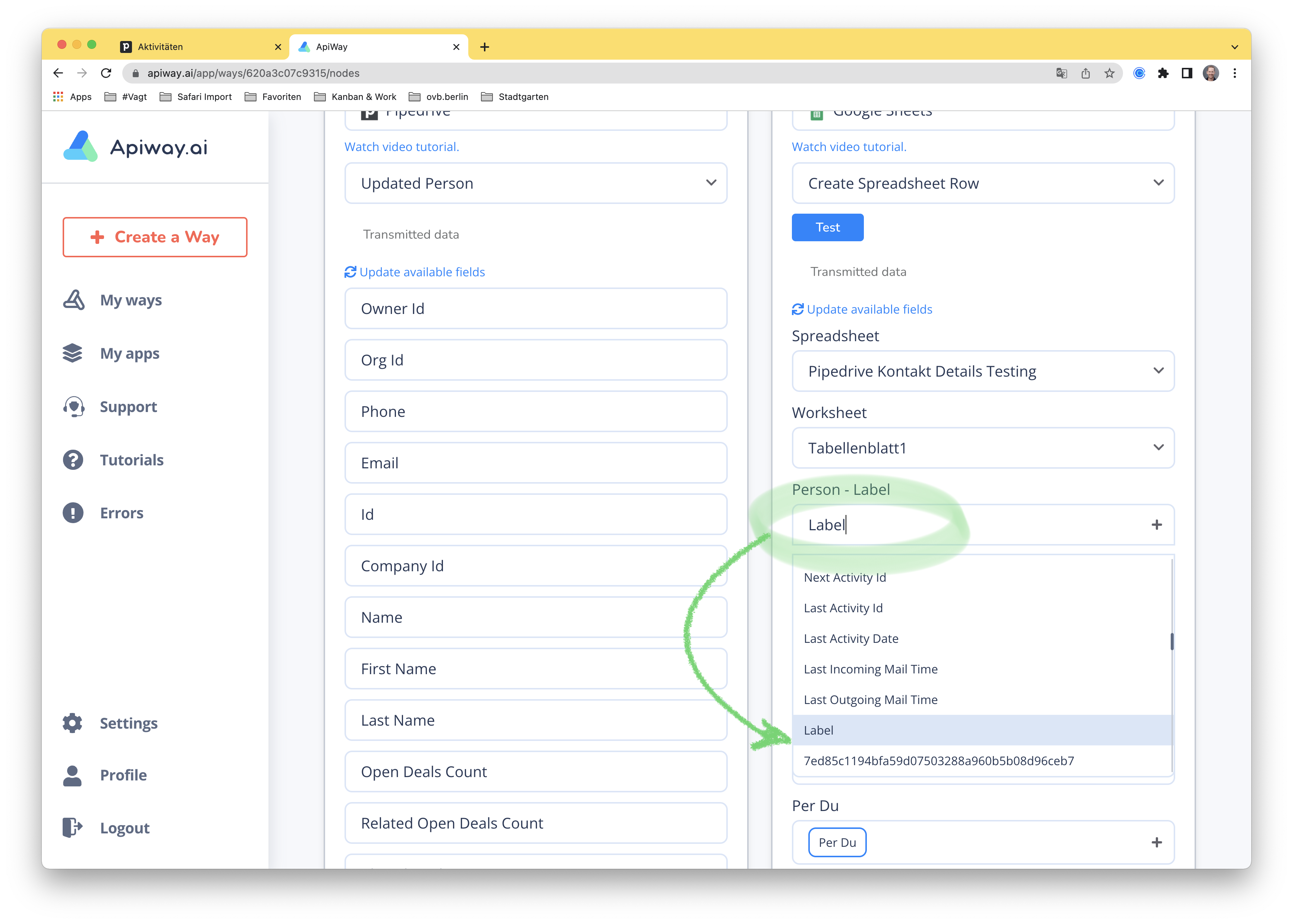

A daily deals website offers numerous types of discounted deals to consumers that they can use on both offline and online stores. The deal can also be for either a product offering or services. As the daily deals website does not own any franchise or brands whose deals it sells, it is mostly an asset-light multivendor business. Below, I have discussed the revenue model of Groupon, one of the most popular daily deals site in detail.
Groupon is a successful player in the daily deals industry. Back in 2008, co-founder of Groupon, Andrew Mason came up with an innovative idea of gathering all the deals available in a local market and putting them online for better leverage. The site also notified that how many customers are showing their interest in the online deals.

Groupon works with only one revenue generation channel, and that is a 50% commission cut from what customers pay to merchants. All other services provided by Groupon, including deal listing on the website, tips to merchants on better deals, etc. are free. But since the deals are so profitable and so many people buy them, Groupon has no trouble making huge money.
In all general circumstances, companies do not reveal their business model. So below is a representative business model of daily deals websites.
A dailly deal website can use the following revenue channels:
● Featured Listings
● Monthly Subscriptions
● Exclusive Partnership
● Commission
If you are planning to start your own daily deals website then you can choose a readymade solution instead of building it from scratch. This is because not only readymade solutions are time and cost efficient but they are also much better than developing a custom website that will require deep research on features.
Below are some popular daily deals software:
● GetSocio
● Yo!Deals
● Daily deal builder
● AlstraSoft
● Wroupon
Yo!Deals is the perfect solution to set up and run a deals-based website that can sell products too & offers the best experience to merchants as well as customers.

For Admin
Admin is the owner of the website, who owns the website and makes money from sales of deals and products and by ad revenue & merchant commissions.
For Merchants
The solution allows merchants to create and edit deals.
For Buyers
Yo!Deals comes with a robust front-end with a smooth navigation to help buyers find the required deals.
● Option to sell both deals and discounted products
● Easy voucher redemption
● Easy to browse and search the best deals
● Responsive System which is easy to access and offers the best experience
● Payment Gateway Integration — PayPal Standard, Credit Card & CIM
● Affiliates management
Visit this page to book a personal one-on–one live demo session of Yo!Deals. Or, you can also explore the instant demo right now.

There’s no specific answer to your question as the cost of any software basically depends on your requirements. Also, the final cost can change depending on the number of iterations you want in the MVP.
To elaborate, as MVP develops on multiple rounds of consumer feedback, it can have several changes in features. All these changes will be additional to the original development cost. For this reason, the majority of software development companies prefer to work on hourly rates.
Now, there’s a huge difference between the hourly rates depending on the country you select for MVP development and the reputation of the company. To give you a brief idea, below are some estimated hourly rates of different countries:

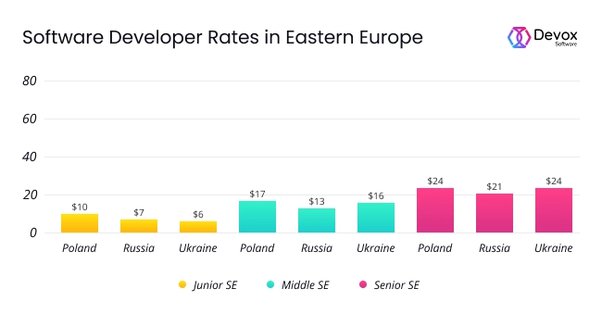
Even when you find an MVP development company that fits in your budget, I will recommend you to consult other companies as well and get a quote. Later, you can compare all companies based on their skills, reputation, portfolio, and customer support.
Some websites that you can use to find cheap but reliable MVP development companies are G2 and TrustPilot. These websites rate and review various companies so that you can skip the hard work. Below are some MVP development companies that have been top rated on G2:
I have posted some links to the G2 profiles of some renowned MVP development companies:
FATbit Technologies: https://www.g2.com/sellers/fatbit-technologies
Scrum Digital: https://www.g2.com/products/scrum-digital/reviews
VStrom: https://www.g2.com/products/web-mobile-app-development-with-product-design/reviews
The Cisco Annual Internet Report claims that, by the end of 2022, 75% of cloud computing workloads and workstations will be in the form of a SaaS model. This means that the SaaS industry is full of opportunity — but also competition.
When working on a custom SaaS development, speed and scalability are vital. If you are not familiar with open-source software, it is free and generally easy to incorporate into another product. It can also be modified or customized to suit your specific needs, making it even more appealing.
Unfortunately, many new businesses using the SaaS model overlook open-source software in the creation process, not realizing that these tools can be used to accelerate growth and build a successful SaaS product.
Please read on to get the lowdown on how to use open source to build your next SaaS product. Some of the many benefits may even surprise you!

“Open source” generally refers to something people can modify and share. The term most often replies to software when the code has been made publicly accessible.
The term promotes open exchange, collaboration, transparency, and community-oriented software development. It’s easy to see how this is an excellent opportunity for many businesses.

The first question to ask yourself — Is my team regularly exploring open source libraries? And are we discussing this option so that everyone knows the benefits of exploring open-source libraries when building SaaS products?
If they’re not searching for existing open-source code as a first step, it’s probably time to remind them that open-source libraries are an excellent place to start.
You might be wondering, what, exactly, is an “open-source library”? Well, simply put is an online source with a range of free-to-use software and code. These libraries usually include code for solving problems software developers frequently encounter.
The list includes, for example, code that:
➡️ Simplifies the use of dates, timestamps, and time zones.
➡️ Helps with the encryption and decryption of data to meet industry and security standards.
➡️ Helps to transform data from one format to another.
By now, I’m sure it’s clear how open-source software and code can be invaluable for SaaS business models. Why reinvent the wheel when the code you need for your product already exists?
Simply take what you need from an open-source library to save time and then modify it as necessary to fit your needs.
Another term we want you to keep in mind is “open-source framework.” An Open-source framework means a network of developers produces the templates for software development to speed up the software development process. What now?
An open-source framework could help you create a complex user interface much faster than writing the code from scratch. It is important to note that when you choose to work with an open-source framework, you take on the specific tools and methods associated with it.
This can be very useful, but it also means that you need to choose carefully to make sure you end up with a solution that’s 100% in line with your needs and goals.
To summarize, using open-source can make your software team’s job a whole lot easier, as they will have to write less code which is very time-consuming.
If they use foundational code from libraries or frameworks, they can focus their time and energy on producing the code for functionality specific to your product.
These fundamental elements will help set your product apart in the rapidly growing SaaS market and make it more valuable and unique.

To be clear, this is different from using open-source frameworks and code. Usually, it’s completely legal and possible to take an existing open-source product and build on it to create your commercialized software product. In this instance, we’re talking about taking the software product in its entirety and adapting it.
Fortunately, entirely usable open-source products exist and are there for the taking. Using an existing product can save your developers a lot of time; perhaps as much as 80% or 90% of the code you need will already be written.
The chances are high that nothing already out there will suit your needs, but this is an excellent solution if it does and is worth checking into it.
Take note:
It’s always best to check in with your attorney to ensure you aren’t violating any intellectual property rights.
The Merriam-Webster dictionary defines the word “complement” as “something that fills up, completes, or makes better or perfect.” Now, who wouldn’t want to make their product better?
Let’s say you’ve created most of your code from scratch, but there are some non-core, complementary functions you need to add to perfect your product. Finding open-source code to use for these secondary features could be the way to go by saving you much precious time.
For example, suppose you’re building a business communication service and need to add some content-creation tools to the offering. You could go digging for content creation-related code that already exists and save time, money, and effort in the process.
So far, we’ve talked about how you can use existing open-source software to enhance your product. But in the spirit of community and collaboration, you can also contribute to open-source projects by making some of the code you’ve written for your software product available as open-source too!
This may seem like a waste of time and energy, but it’s always good for software engineers to build their reputations. And if they are linked to you, it can also help you build your brand awareness. People always appreciate generosity and sharing and you’ll be doing good in the software community by creating much-needed code or finding solutions to frequently encountered problems.
Learn more about the benefits of using open source for your SaaS product and how to avoid its risks for SaaS businesses on PayPro Global’s blog.
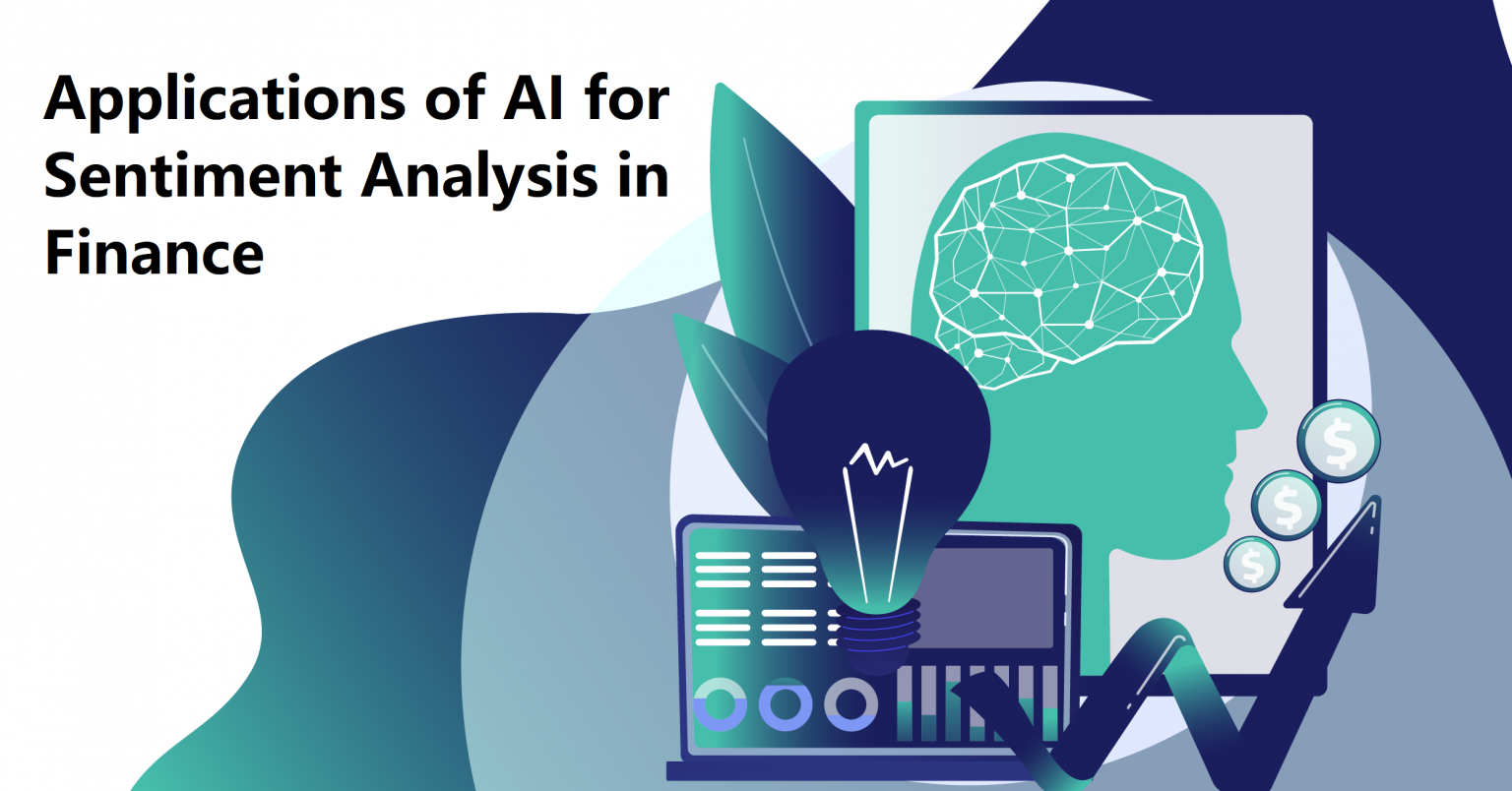
Nowadays, as the world goes digital, the popular notion in the finance industry is that with the integration of Artificial Intelligence and machine learning with sentiment analysis, you can forecast future events by analysing the past, leveraging the finance data. They can mimic cognitive decision-making while avoiding the behavioural biases that humans are prone to.
According to research, AI in fintech commanded a market value of $7.91 billion in 2020 and is predicted to reach $26.67 billion by 2026 (a CAGR of 23.17 per cent). Several finance giants across the globe have already put their steps forward to invest in business units focused on AI and ML implementations that could predict their clients’ sentiments to market dynamics. Indeed, AI and ML tools are regarded as the most influential facilitators of competitive and strategic edge in the finance industry. Here is how AI empowers the finance world in sentiment analysis to upgrade their products and services.
These are some of the most prominent AI-backed sentiment analysis applications the finance industry could harness –
Financial institutions have traditionally amassed an enormous volume of data and information records. Some conventional banks even retain the required resources for AI-based sentiment analysis projects. Recognising the power of AI in information search and discovery applications for the finance sector is crucial for proficiently exploring enormous data banks to generate valuable, actionable business insights.
AI-backed software solutions can help financial institutions power a data collection tool that could serve as a search engine for the financial market progressions. The database could then be revised regularly to develop a comprehensive index of all internal documents, such as the latest deal signings, public corporation filings and conference call transcripts, using NLP and machine learning. The search engine then decrypts these documents’ subjects, notions, and theories to index relevant investing information.
In banking operations, the same technologies that fuel the performance improvements in machine learning models of search engines are being exploited. Object recognition systems analogous to those used in search engines, for example, are utilised to detect news and social media interactions pertinent to publicly listed corporations. The motivations for banks to access additional data may expand as more companies employ NLP and machine learning approaches.
Using natural language generation (NLG), Al-powered software solutions can assist financial firms in conveying insights gathered from structured data. Users can incorporate various tools into their ongoing business operations to help with functions like report generation. For example, a financial firm that employs human analysts to provide narrative reports, like a comprehensive sales report, could automate the compilation of those documents by training the software feeding current reports.
Analysts and technical experts must train the NLG algorithm to obtain reliable and precise reports. Then, the software may learn to recognise correlations in the reports and determine which portions of the reports are the most substantial, allowing firms to ultimately generate reports in natural language with the optimum sentence phrasing, formats and layouts.
Also, banks and financial entities can employ AI capabilities to automate the process of evaluating and gathering insights from customer surveys using NLP. Various software tools use NLP to classify the responses from the customer survey data. They then determine the tones-favourable, critical, or neutral in the content.
Text and sentiment analysis systems assist banking and insurance businesses in assessing client and industry sentiments. They are devised using machine learning and NLP approaches. By integrating their text and sentiment analysis tools, APIs allow users to automate internal processes requiring unstructured data analysis and interpretation, such as text documents or photos.
Then the tools employ NLP and image recognition to train models utilising statistical information from banking and financial accounts. The models get trained to categorise, consolidate, and analyse data dynamically.
AI-backed solutions like PreCeive, a plug-and-play software tool, allow financial analysts to gauge customer mentality, reactions, or sentiments through survey questionnaires or other customer engagement data such as call transcripts, emails, or SMS. PreCeive then uses natural language processing (NLP) and machine learning to categorise and uncover insights about individuals, corporations, concerns, products, and activities from text-based datasets. Several businesses can deploy such tools to automate their workflow and offer insight to their customer support and marketing divisions obtained from emails or any other text interaction.
The AI-enabled solution providers accentuate two principal approaches to sentiment analysis in finance. The first one is the development of powerful search engines that can seep through huge volumes of news, microblogs, and social media content with the capability to index and contextualise the most relevant details from the industry point of view. The other involves leveraging existing data repository and corporate documents to comprehend, categorise, and produce concise reports from raw data reflective of favourable, critical, or balanced sentiments.
AI for sentiment analysis cannot be a one-size-fits-all solution to the issues that banks and financial institutions encounter periodically. Instead, industry leaders can leverage it as an instrument that can assist them in exploring ways to enhance and refine insights and findings that already prevail in their data. One thing to keep in mind is that the formulation and establishment of use-cases for tailored AI integrations can take three to five months on average.
The performance, efficiency, and reliability of AI tools are only as perfect as the quality of data and information they consume. Moreover, the models would still need fine-tuning for reliability and accuracy long beyond that timescale.
We are all adjusting to the newfound necessity of prioritizing an ever-increasing flood of quantitative insights as we live in the era of information. By following the never-ending stream of media, research, blogs, tweets and other social media, it is possible to gain insight into macroeconomic patterns, how marketplaces change over time and even how corporations perceive and adjust to their environment.
Textual data, such as surveys and reviews, as well as interview transcripts and other forms of textual quantitative insights, are used by corporations, government agencies, researchers and educational organisations to gather information. Even though human beings are incapable of reading, gathering and evaluating millions of pages of text, natural language processing (NLP) breakthroughs have made it possible for anyone to spot trends and discern a person’s emotional state from a vast number of words or phrases.
The capacity to sift through a large amount of data and uncover the most important insights for your firm has become a strategic advantage since data is now viewed as a corporate asset. NLP trends can help organisations and investors get a competitive advantage by unearthing insights and patterns hidden in millions of pages.
Let’s take a look at examples of how natural language processing might assist you in quantifying human language and why that’s important in your research.
How Do C-suite Leaders Use NLP to Learn about the Density of Keywords? Text analytics uses various linguistic, statistical and machine learning techniques to transform unstructured text input into useful information. C-Suite interest might use this information to see how well their marketing campaigns are working or to keep tabs on the most common customer complaints before deciding on how to respond or improve service. Keyword extraction and the detection of structure or trends in unstructured information are two additional ways that natural language processing (NLP) might assist with text analytics.
The availability of large amounts of data is critical for machine learning and even more so for deep learning. On the other hand, quality should not suffer as a result of your decision to prioritise size over everything else. When it comes to data preparation, the most important questions for ML researchers are:
When gathering data on your own or utilising publicly available datasets, these aspects are important to keep in mind. Let’s take a look at each of these concerns one by one.
No one can predict how many customer reviews, emails, sentence pairings, questions and answers and other elements you will need to achieve a reliable output. The size of a data set might be challenging to determine, but a few approaches can assist you in this process.
People are constantly working on NLP projects, and their findings are being published in academic journals and blogs. Search for specific solutions that will at the very least provide you with an estimate. Make use of your knowledge or consult with domain experts to accurately determine how much data is required to convey the intricacy of the activity.
Using statistical approaches, it is possible to determine the sample size for any sort of study. Consider the number of features (with x percent more instances than the total number of options), model parameters (with x examples for each parameter), or classes.
These methods are unreliable, but they are still widely used and will get you started.
In different areas of application, there are differing perspectives on what constitutes high-quality data and what does not. In natural language processing, one quality measure is particularly important: representational.
Representational data quality indicators consider the ease with which a machine can interpret the text. Within the dataset, the following issues have been identified:
Understanding consumer feedback and identifying your company’s strengths and flaws are critical to the success of any organisation. Website evaluations, chat interactions, conversation transcripts and social media comments are all examples of information that firms now have access to that can provide them with a search summary.
The use of natural language statements or question fragments made up of many keywords that may be parsed and ascribed a meaning opens up more chances for individuals to examine their data in new and interesting ways. It has been demonstrated that using language to explore data increases both the level of accessibility and the barrier to analytics across businesses, even for those outside the expected group of analysts or software developers.
If you wish to assess whether data is favourable, negative, or neutral, sentiment analysis (also known as information extraction) could be a natural processing technique to use. Positive and negative feelings in the text can be detected through sentiment analysis. Customers’ perceptions of a brand can be assessed using this technique in social media posts, as can the company’s reputation.
The sentiment analysis method has three possible applications:
These systems typically use rules written by humans in order to determine the subjectivity, polarisation or subject matter associated with an opinion. Stemming, tokenisation, part-of-speech tagging, and parsing are all examples of NLP techniques that may be used in these rules.
Whenever there are more positive words in a passage, the algorithm produces a positive sentiment and vice versa. As long as there are no odd or even numbers, the algorithm will return a neutral feeling.
Unlike rule-based systems, automatic approaches do not rely on a set of predetermined rules but rather on machine learning.
Hybrid systems incorporate the best aspects of rule-based and automated systems. One major advantage of using these approaches is that the findings are frequently more accurate than with traditional methods.
NLP is being used across the financial world, from consumer banking to hedge fund investment, and it is becoming increasingly popular. Natural language processing (NLP) techniques such as sentiment analysis, question-answering (chatbots), document categorisation and topic clustering are employed when dealing with unstructured financial data.
A financial system that can make intelligent decisions in real-time can be designed using NLP and machine learning approaches. A company’s evolving character can be tracked with NLP to assist in creating solutions that enhance cash flows. Investment operations, for example, can benefit from NLP in the following ways:
In recent years, natural language processing technologies have become significantly more dependable, consistent, accurate and scalable, allowing financial decision-makers to gain a comprehensive understanding of the market and make better-informed decisions. In the financial industry, natural language processing (NLP trend) is being used to drastically reduce tedious activities, speed up deals, identify risks, interpret financial emotions and design portfolios while automating audits and accounting.
Growing businesses are often encouraged to think big, think national, and, ultimately, think global. But to increase your reach and revenue in international markets, you need an international expansion strategy that must also include localization strategies.
Yes, we can hear you asking: Why think local when I’m trying to go global? The answer is simple: to be successful, you need to create a frictionless experience for every shopper who interacts with your brand and product throughout the customer journey, wherever in the world they may be.
That’s why we put together this comprehensive guide on localization strategies which covers everything you need to know to grow globally. If you have more questions, you know where to find us, and we are always here for you!

Before we go into the nitty-gritty of localization, let’s first take a look at the terms you’ll be seeing in this article:
Localization is the process of adapting your product, information, content, or marketing campaigns to suit the needs, preferences, interests, and context of customers in a specific country, region, or foreign market. The most critical localization factors to consider are language, culture, religion, politics, and regulations.
Localization services are the tools used to modify a product to adapt to the needs and preferences of users in different regions. Businesses looking to expand beyond their own regions should use these services to build trust and confidence in new markets.
Some good examples of localization services include:
👉 Translating a product into a local language.
👉 Changing units of measurement to suit the intended new market.
👉 Checking whether font and character sizes work in other alphabets.
👉 Re-working visual elements in games to make them resonate with the cultures you’re targeting.
➡️ Localization Marketing
Like search engines or video marketing, the localization process is a subsection of the bigger marketing strategy, which is promoting and selling your products or services. It requires purposeful planning and a commitment to scale your business’ marketing efforts by paying close attention to local factors, customs, and needs.
➡️ Global Marketing
Global marketing, quite predictably, refers to the marketing strategy, practices, and activities that lead to identifying and successfully attracting customers on a worldwide scale.
A global marketing plan should include specific strategies for selling your product in different countries and regions and an overarching set of goals to achieve sustainable growth on an international level. Therefore, your localization process and strategies form part of your bigger global marketing plan.
A global marketing plan should include your:
👉 Value proposition
👉 Target audiences
👉 Business models
👉 Success factors
👉 Marketing mix
👉 Resources
It’s essential that your plan includes the “local factor.” What cultural, economic, religious, and political factors will affect your brand identity and success in the markets you’re targeting? It’s critical information you should be considering and monitoring regularly.
➡️ What is Global Marketing Localization?
Global marketing localization means taking your international marketing plan and localizing each element based on your different regional target markets. In short, you are making it familiar and relevant to each segment of the population you plan to market.
For example, components of your overall marketing plan should include:
👉 Your website
👉 Social media campaigns
👉 Press releases
Global marketing localization requires an in-depth understanding of customers in many different contexts, such as:
👉 Economy
👉 Social trends
👉 Values
👉 Technology
👉 Legal compliance regulations
It’s pretty evident that you need customers for your business to survive, and what business doesn’t want more customers? The truth is that, with a little bit of effort, you can open up a world of exciting new opportunities. If you can scale up your marketing efforts and reach out to customers in different regions, you will, without a doubt, increase your customer base and grow your business.
A good localization strategy will make customers feel like they’re getting the best possible customer experience. To achieve this goal, you must understand their needs and always consider them in all customer service areas. This is why businesses should prioritize their localization strategy. It is a critical, tried-and-tested tool for improving global revenue and customer loyalty across the board.
Localization provides a competitive advantage by expanding your reach and improving global brand awareness. For example, customized, localized content is likely to rank higher in search engines because it enhances the quality of results for users.
Seamlessly integrate localization to help your business overcome common scalability problems, such as struggling to retain clients or meeting your growth targets. Good localized content and information are more likely to lead to loyal customers, as the global target audience will feel like your brand speaks to their specific needs. Also, as you sell more products in new regions, you’ll have the opportunity to sell your excellent business reputation by word of mouth with new users.

Localization can help to humanize your brand.
If done well, customers in every corner of the world will look at your products and feel as if your brand speaks to them and addresses their needs. Customers are more likely to engage with your brand through social media, your website, and other channels if they see themselves reflected in your marketing campaigns and content. They’re more likely to engage in social media posts that understand cultural differences and reflect their cultural norms.
Localization shows that your brand respects other cultures and values and that you’re making an effort to meet your customers in their world. Most importantly, it shows that you understand them and their needs.
Localization will increase profits, which are, of course, necessary for businesses looking to scale globally. Your investment in marketing is likely to be more effective, as a solid localization strategy will increase the potential for sales across a broader target market. If customers engage with content and information they understand and enjoy, they’re less likely to need customer support. Because of this, localization can also lead to significant savings in the long run, which is a win-win situation.
Ready to get started with localization? Explore the 10 simple steps to help you implement your localization strategy and ensure your localization efforts have a positive impact on your global revenue on PayPro Global’s blog.
According to Gartner, an estimated 30% of the $102 billion spent on SaaS in 2020 is not even being utilized! One company researched this so-called “SaaS sprawl” and found that businesses have, on average, 600 SaaS subscriptions — much more than most of them actually end up using.
Managing how much money you’re spending on SaaS forms part of what’s referred to as Technology Value Optimization (TVO). This process aims to avoid waste, mitigate security threats, and cut costs. So what exactly is Spend optimization, why does it matter, and how can you use it for the benefit of your SaaS business?

Spend optimization is when businesses focus on reducing the number of SaaS apps and services they use. They do this to ensure the products they pay to use are the best fit for their organizations and encourage canceling any product subscriptions that are over-licensed or under-utilized to save money. The TVO helps with SaaS cost optimization, offering businesses an opportunity to cut unnecessary expenses while retaining the value their most relevant SaaS products bring them.
There are 4 key reasons why it’s worth focusing your attention on SaaS optimization and figuring out exactly what you’re spending on your SaaS usage.
By eliminating duplicate software, you can help your employees use the most appropriate tools when it’s relevant to them. All companies should identify the SaaS products that best suit their business needs. Monitoring adoption and encouraging collaboration on software across various teams are key in this process. Obviously, removing duplicate software improves efficiency and reduces costs.
To be truly successful at spend optimization, you need to understand the importance of each piece of software you subscribe to. To do this, view reports and track spending and usage data regularly for the apps and services you subscribe to. This feedback can help you prioritize the benefits of the tools you use to buy and renew software subscriptions.
With complete visibility into your SaaS licenses and spending, it should also become easier to track when employees are using apps they shouldn’t be using. You’ll be able to add and remove software users as required, significantly reducing security risks and unwanted user access, as well as reducing costs.
Ultimately, SaaS spend optimization is about reducing costs. With the right processes in place, you’ll be managing and controlling your software spend, identifying waste from unused software, and dealing with unused or underutilized SaaS apps. If done correctly, the optimization of accounts and licenses can lead to a significant reduction in your overall SaaS spending costs.

The first step in optimizing your SaaS spending is taking stock and creating an inventory of your expenditure. Visibility is key.
The inventory should include the number of user licenses, contracts, and all expenses incurred. It’s important to know what your business is using and why.
This first step will help you make informed decisions on optimizations in the future.
To achieve spend optimization, you need to keep a close eye on your SaaS usage. If you have a large business with many different types of software and subscriptions, your SaaS needs and spending may change frequently. We recommend conducting an audit every few months to ensure you’re using all your SaaS applications effectively and that you still require them.
Set priorities to keep your focus clear when starting your spend optimization process.
The easiest way to do that is to prioritize applications by:
➡️ The total investment or spend
➡️ The renewal date
➡️ The number of users
➡️ The business function or value
Focusing on the most expensive SaaS applications will make for the quickest cost reduction.
Always review apps before their renewal date to ensure you are not locked into costly or unnecessary subscriptions. The more users an app has, the more likely it is that employees aren’t using it or are not using it to its total capacity. Check in with users to see if there is an actual need for them to have a license.
Lastly, some apps are integral to a business’ functioning, while others are less essential. By following these steps, you will understand that each app’s business value compared to its total cost is the key to spend optimization.

When aiming to optimize your SaaS spending, decide your ideal utilization rate. Perhaps your business is using 70% of your SaaS licenses. We recommend setting a goal for SaaS utilization — while 90% seems like a very high percentage, it is achievable for many businesses.
The gap between your current and goal usage is where you should focus your energy when analyzing your SaaS spend. Work with your newly identified, priority products first, as they’re the most costly or the most valuable.
The ultimate goal should be to improve your utilization percentage to 90%. This will lead to significant cost savings, ultimately benefiting your business and allowing you to make better use of your funds.
Explore the complete list of SaaS spend optimization steps and learn how your business can benefit from it on PayPro Global’s blog.
So your eCommerce business is experiencing rapid growth. You’re scaling your operations and increasing your reach across the U.S and into new global markets. Excellent news, right?
Well, yes and no.
One thing is for sure: as your SaaS company scales, staying compliant with sales taxes becomes increasingly more complex, both in the U.S and internationally. The importance of prioritizing compliance cannot be overstated.

Sales tax is a consumption tax that the U.S government charges on the sale of goods and services. Retailers generally collect sales tax at the point of purchase and then pass it on to the government. Since the birth of eCommerce, this has been a somewhat confusing endeavor, and digital goods have made it even more complex.
In short, your business is liable to pay tax in a specific state or jurisdiction if it has a nexus there. But more on this later.
Many factors contribute to the complexity of sales tax compliance and financial reporting within the United States, and each one is crucial for SaaS companies to understand. Let’s start with the most critical elements to get to grips with if you are scaling your business:
When talking about sales tax rules in the U.S, ‘Nexus’ refers to the level of connection between a specific taxing jurisdiction and an entity. The taxing jurisdiction can be a state or a district, and the entity, in this case, is the business itself. When this connection is established, a taxing jurisdiction can impose taxes on SaaS companies.

A physical nexus means that any business with sufficient physical presence in a specific jurisdiction must pay tax rates there. This presence includes having a property in a jurisdiction or employees working there.
Economic nexus refers to a threshold of economic activity after which a business must pay taxes in a particular jurisdiction. This is usually measured in terms of a monetary threshold, the total number of transactions over a specific period of time, or both.
As online sales increased across the U.S in the 2010s, states became aware they were losing billions of dollars of sales tax. As a result, they began to push for a new standard of compliance.
Before 2018, nexus in the U.S generally referred to physical nexus, and you would only have to pay sales tax if you had an actual presence in a state.
However, after the judgment of South Dakota v. Wayfair in June 2018, sales tax in the U.S became much more complicated for online sellers. The Supreme Court agreed with South Dakota that states should be collecting sales tax where businesses have economic nexus. Since this precedent was set, most states have followed suit and imposed their own nexus standards.
So, if your business sells SaaS, Software, or digital goods and services within a U.S state, you may be required to register and pay sales tax in that state regardless of whether or not you have a physical nexus there.
Additionally, it’s essential to clarify that you are not exempt just because the transaction takes place online. If your sales exceed the nexus threshold in a state, you’ll need to pay taxes.
It is safe to say that with all these legal changes, many businesses have had to scramble to comply with audits as states try to reclaim lost revenue.
Currently, there are over 14,000 tax jurisdictions in the U.S, each with its own rates, rules, and regulations, making staying on top of taxes incredibly confusing and time-consuming.
In the U.S, sales tax legislation is different in every state, charging differing base rates. Then each jurisdiction within a state can add more tax on top of that. For instance, a county could impose an additional sales tax, while a district could impose yet another tax on top of the previous two.
This means that the total could be significantly more than the state rate would typically be.
Different states set different sales thresholds, and they may also have different evaluation periods and registration timings. Because of these complexities, it’s essential that SaaS leaders and founders check each state’s nexus laws.
To help you better understand the complexity of global tax compliance, we have created our SaaS & Software Tax Panic Scale
. It gives each U.S state (and many other countries, states, and provinces around the world) a score based on a range of factors, including its tax rate and tax registration complexity.
SaaS, Software, and digital goods companies notoriously suffer from the complexity of taxability. Each time you add a product or service to your arsenal, it potentially creates complicated changes to your sales tax nexus. Software is taxed according to numerous categories and criteria, and the system hasn’t always kept up with changes in technology.
Since products can be taxed at different rates depending on who purchased them, where they bought them from, and whether the item is taxable in a particular state or jurisdiction, this situation is destined to cause confusion and frustration for company owners, no matter their experience or business size.
There is simply no way around it; you must register for sales tax in every jurisdiction in which you have nexus. As mentioned before, this could mean you’ll have to keep track of different filing deadlines and requirements for multiple states.
The frequency of filing differs in many states. Also, you may need to pre-pay part or all of your sales taxes, which may change as your sales grow in a jurisdiction.
In short, it often becomes clear very quickly that if you have nexus in many states, it may become too much to handle in-house.
There is a saying, “the devil is in the details,” and it seems very fitting regarding tax. Different tax return forms require so much varying information that it can be easy for even the most competent SaaS company to mismanage this task.
For instance, a state can reject a return for something as small as leaving off a signature, and some states require you to round amounts up, while others need them rounded down. Because of these intricacies, we caution SaaS businesses to seek the help they need to mitigate bringing this type of hurdle into managing your business.

Some states allow voluntary disclosure agreements, which means you can remit sales tax liability with limited look-back periods and no penalties. But If you realize you are liable for backdated sales tax, you must have a solid plan before filing them.
To summarize, It’s always better to get out in front of historical tax liability. A good motto, in this case, is don’t ignore it and hope it will go away!
Because individual states set their own taxable periods, some will want you to file your taxes annually, while others require you to file quarterly or monthly. Dealing with the differing taxable period requirements can be overwhelming, which is another reason for considering outside help with your taxes.
If you are unsure if you can manage all aspects of tax compliance, it is better to err on the side of caution and ensure that knowledgeable professionals are managing this side of your business.
Read on to learn the 8 key sales tax considerations when scaling up your SaaS business, so that you can avoid risks and ensure sales tax compliance on PayPro Global’s blog.
As an eCommerce SaaS business, it’s likely you’ll end up selling your products across national and global markets.
However, there is a significant challenge in handling complex transactions, especially when a SaaS business goes global. You suddenly have to process credit card payments, billing, tax, and legal compliance. And all this while at the mercy of an industry full of ever-changing rules and regulations.
The good news is that using a Merchant of Record (MoR) model can make your job a lot easier, simplifying business operations while minimizing risk.

An MoR is a legal entity or organization that acts as a reseller between two parties in an eCommerce transaction. The MoR takes responsibility for reselling its vendor’s products to their customers around the world, all the while providing you with the tools needed to manage your overall business operations.

The MoR is responsible for the entire customer interaction, from the moment the buyer initiates the purchase process until the customer receives their product. Even then, the MoR is still working away in the background throughout the entire customer lifecycle, taking responsibility for subscription management, support, reconciliation, managing refunds, and chargebacks, maintaining international tax compliance, and taking care of currency conversion.
The MoR is also responsible for ensuring compliance with the Payment Card Industry Data Security Standards (PCI DSS), data privacy regulations, and other rules and regulations specific to the countries and regions they operate in.
The MoR is essentially the seller of the product, taking care of all the complex responsibilities that come with it. This means there’s no need to assume financial liability or maintain banking relationships, merchant accounts, and payment gateways.
The MoR model is simple:
➡️ A customer initiates the purchase process on the vendor’s website and is then taken to the checkout page, hosted by the MoR solution.
➡️ When the shopper makes a payment, a single transaction occurs between the MoR (reseller) and the end-user.
➡️ The MoR passes the right of use ownership for the product from the vendor to the customer.
➡️ When the transaction is complete, the soft descriptor on the customer’s credit card statement is usually the website’s name where the purchase took place or a combination of the vendor and MoR.
➡️ The MoR is responsible for any post-sale disputes. For example, should a customer attempt to reverse the charges by initiating a chargeback, the MoR will be liable.
One of the main benefits SaaS businesses with global reach gain when working with an MoR is the all-inclusive nature of the model. Besides vendor & shopper support, marketing tools, CRM & BI capabilities, lead management, and a large number of languages, currencies, and payment methods, the MoR also takes care of all financial, legal, and administrative work, including payments, billing, taxes, and compliance.
SaaS and Software companies that sell locally may be able to act as their own seller or MoR as it’s more feasible to manage transactions within your own country. However, working with an MoR solution is still beneficial as even local taxes can get complicated. Case in point, look at the 14,000 + tax jurisdictions in the U.S.
Like many other businesses, eCommerce providers face various risks that can affect growth and damage customer trust.
➡️ Identity theft
➡️ Intellectual property violations
➡️ Poor customer service
➡️ Credit card fraud
➡️ Cyberattacks
➡️ Privacy issues
➡️ Non-compliance with taxation requirements
So what is the best way to minimize or even remove these eCommerce risks? Work with a Merchant of Record eCommerce solution with a track record for success.
Learn more about the benefits of an MoR model and how it can reduce eCommerce risk for SaaS businesses on PayPro Global’s blog.
On August 20th, 2021, China passed its new Personal Information Protection Law (PIPL) — the first of its kind to be seen in the East-Asian country. The law creates a new landscape around security and the protection of personal information.\
This personal information protection law will have far-reaching effects on business operations in China, similar to what the European Union’s (EU’s) General Data Protection Regulations (GDPR) has had on the world.
China’s PIPL provides a new set of rules on how businesses can use Chinese citizens’ data, and tech companies, in particular, will be affected; not just in China, but around the world.

From November 1st, 2021, organizations handling Chinese citizens’ data must meet certain conditions laid out in the PIPL. If your SaaS business is already GDPR compliant, you should have an easier time reaching PIPL compliance levels.
However, if you haven’t implemented GDPR practices, your business may have to spend extra time preparing for China’s PIPL. The law adds another layer of complexity to data security compliance for companies doing business in China.
China’s PIPL is a data privacy law that imposes new data-handling requirements. It’s perhaps the most stringent set of data laws in the world right now.
The personal information protection law puts into place protections and restrictions on data collection and transfer. In particular, the law focuses on apps that use personal information to target consumers and provide personalized advertising to them.
The PIPL also aims to improve personal information protection by preventing data from being transferred to other countries with less stringent data protection or security policies.
The PIPL is China’s third law aimed at the regulation of technology. In 2017, the Cyber Security Law was enacted, which was then followed in early 2021 by the Data Security Law. Now, the PIPL completes the framework, with a specific focus on personal information protection.
The PIPL has extraterritorial applications too. This term means that the regulations don’t only apply to activities within China; under certain conditions, they apply to handling citizens’ personal information outside of Chinese borders too.
These conditions are as follows:
➡️ Where the purpose is to provide products or services to people inside China.
➡️ Where activities of people inside China are analyzed or assessed.
➡️ Any other circumstances provided for in law or administrative regulations.
So, it seems that even without any presence in China, SaaS businesses that process the personal information of Chinese citizens will be bound by this law.
Effectively, this means that almost every major business in the world will need a PIPL compliance strategy. And if your business deals with the personal information of individuals located within China, you’ll need to ensure you’re consistently meeting the requirements of the PIPL.

Under China’s PIPL, personal information is defined as any information such as video, voice, or image data relating to an identified or identifiable natural person, notwithstanding whether the information is captured via an electronic form or another type of form. This definition excludes any anonymized information.
Beyond this, the PIPL defines sensitive personal information. This term refers to the personal information of which the leakage or illegal use could easily violate the personal dignity of a natural person or harm personal or property safety.
Examples of this kind of information include biometrics, religious information, medical information, home addresses, financial information, and personal information of those under 14 years of age.
Well, the liability could be on SaaS businesses to keep sensitive personal information separate from other personal information to help mitigate the risk of full records of personal information being shared when consent hasn’t been given.
Also, sensitive information must only be used when it is relevant for achieving a specific purpose, and it must be protected at all costs by the processor.
Find out how PIPL can affect your business and learn the main steps to develop a PIPL compliance strategy on PayPro Global's blog.
Digital marketing is rampant and inevitable, and sending emails has been an integral part of it. Sending personalised newsletter recommendations through email is a direct and cost-effective approach to garner higher conversions, spread brand awareness and boost favourable results for the business.
Artificial Intelligence plays a crucial role when it comes to sending personalised newsletter recommendations through email. The emerging trends in AI across various industries have improvised several processes. Email marketing has become more powerful and upgraded with the help of AI, and the results are even better.
AI has taken email marketing to new heights and is undoubtedly the future. AI through email marketing generates revenues, decreases costs and accelerates sales. AI-powered tools help you send better emails, produce better results, conduct AI-powered searches, enhance open and click rates and help you make more money from email marketing campaigns.

AI is massively growing, leading to the unprecedented development of email marketing. AI follows these three steps to accelerate the email marketing process:
Further,
AI-powered tools help in writing portions of emails and subject lines. It helps in optimizing send times and sending personalized information through emails to each lead. It can also help in cleaning up email lists and can automatically create email newsletters with unprecedented personalisation.
AI uses various technologies like ML- machine learning, NLP – natural language processing, deep learning, computer vision and more in email marketing to perform specific cognitive tasks better than humans.
For example, AI personalised document recommendations offered by Amazon and Netflix to offer products and movies you might like, making assumptions about your preferences.

AI applies algorithms and generates attractive subject lines that can attract higher click-through rates. This application considers every marketing campaign before it optimizes your subject line over time.
AI incorporates hyper-personalisation in emails that increase your overall customer engagement rates. Using predictive analytics, AI can apply complex algorithms, ML and customer data to predict the future behaviour of customers based on trends and previous interactions. This helps in creating customised emails that are personalized for each customer.
Segmentation is important in many areas, especially when subscribers have different choices, preferences and interests. AI and ML apply to segments that can bifurcate your subscriber list based on parameters like a position in the sales funnel, purchase history, geographical location, demographics, etc., to help you target your customers better. You can get access to accurate details of customers and their behaviors so that you can categorize them into distinct groups.
Too many or few emails can bring you at risk of being superseded by competitors. AI optimises the email sending time by scrutinising the user’s activity history. Based on the downtime of the customer, his time zones and personal habits, AI can schedule the right time for sending the emails. For instance, Amazon uses AI for cart abandonment through email with an incentive of free delivery considering the privacy policy.
AI ensures that your email reaches its intended target and can use historical data to break your marketing campaign into sub-campaigns, then structure and deliver more targeted emails to maximise inboxes.
As per a recent report, big brands like Netflix and Amazon use AI in sending product recommendation emails to their customers based on their browsing, daily activity, choice of streaming/products, purchasing history, etc. This approach helps businesses to enhance their click-to-convert ratio on emails and the loyalty of the customer. For example, an email by Netflix recommending users for shows or series that they may have watched in the past considering the privacy policy.
AI and predictive analytics can extract customer data based on their behaviour and interests. Effective email campaigns can be formulated to inform and engage customers, eventually maximising the ROI and revenues.
Big data can help in the personalisation and automation of an email marketing campaign. It helps businesses segment subscribers to create more personalised information through emails. It enables and analyses huge sets of data to avoid all the clutter that marketers make manually.
Email newsletters contain personalised content curated for every single user, which improves subscriber engagement. AI automates hyper-personalised content through”smart” newsletters increasing reader engagement and providing rich insights back to the brand. AI can create a weekly newsletter that is personalised for every single subscriber, based on his preferences. This kind of segmentation is difficult for humans to manage.
AI-powered technology can clean up email databases, eliminate out-of-date contacts, update information about the user – for example, job titles, phone numbers and other information and improve deliverability.
AI technology aims to improve the email marketing process by cutting down the time from testing and allowing businesses to work with more combinations of messaging elements. This enhances conversion and revenues.
AI and machine learning help you discover new areas and subscriber groups based on basic information such as age, behavioural signals, location and purchase history that can be transformed into new and distinct marketing segments.
AI helps you identify and monitor the preferences of people who have their personal data anonymised. As soon as the data becomes part of a large dataset, AI can de-anonymise this data based on inferences from other devices and use high-end technologies like encryption and secure-server accessibility to maintain privacy.
It is a misconception that since AI uses personal data to make recommendations to businesses, the privacy and security of consumers may get affected. AI has the potential to enhance privacy protection. Organisations can reap the benefits of AI to accelerate data privacy to classify sensitive data across a data ecosystem.
AI uses compliance methods and ML techniques to protect this sensitive data. AI ensures the highest levels of customer privacy in streamlining interactions, especially when automation has become so rampant. It serves as the one-stop for managing data, so it helps constrict the data using standardised privacy practices.

You need to produce new leads, yet how? What does it take to get individuals who truly need what you're selling? It takes assurance and expertise, however it additionally takes information. To start your education, check out the many helpful tips and tricks below shared by Thomas Salzano.
Construct your quality on LinkedIn. LinkedIn is the most business-accommodating online media channel out there. Individuals utilize connected in to organize and surprisingly handle new arrangements. It's the ideal spot to set out lead age open doors for yourself as well as your organization. Put resources into a Premium enrollment as it will permit you to see each and every individual who has seen your profile.
Try not to succumb to the conviction that creating leads requires a major financial plan, since it doesn't. Conversing with individuals over the Internet is extremely efficient and you can be exceptionally viable assuming you realize how to do it. Focus on your crowd unequivocally, ideal the source of inspiration and make it as simple as workable for individuals to connect to your deal.

Make a proposal to potential leads that is difficult to reject. This can be a rebate, a part with, or some wellspring of data that they've been kicking the bucket to have. It should be pertinent to them, or, more than likely you'll never get them to react. Attempt maybe a couple things to see what works the best.
Find out with regards to the purchasing cycles identified with your business when creating lead age plans. Most shoppers think about offers, research it and afterward settle on a purchasing choice. At the point when your deal is focused on for this cycle, you will affect how effectively they choose to purchase from you.
Look at occasions in your space and check whether there's a way you can utilize them to create leads. For instance, assuming there is a cycling race, purchase a sponsorship bundle. Then, at that point, you can get yourself on TV discussing it, or in the paper, or simply converse with individuals who are there to watch.
Don't pre-judge your lead gathering strategy. However you might think you won't get extraordinary outcomes, or you are excessively certain with regards to the achievement, you can't be certain. The best way to know whether your lead age is working is to set it in motion without assumptions about outcomes.
Utilize your telephone for your potential benefit, and begin settling on decisions to sort out who requires your items. This will assist you with producing a large number of leads. Regardless you're selling, somebody who might be listening is searching for it.
Take a gander at your rivals to see what strategies they use to create leads. You don't have to waste time when you will advertise. Customarily, your rivals have effectively accomplished the difficult work for you. Assuming that you see them utilizing specific strategies intensely, there's a decent possibility they are doing as such in light of the fact that it works.
Many individuals disregard LinkedIn with regards to systems administration and lead age. They center more around other online media locales. However, assuming you realized that change rates were vastly improved inside LinkedIn networks that have been figured, you wouldn't be holding on to utilize this help. Use LinkedIn to assist you with getting new leads!

You want to have a timetable on your business schedule concerning your lead age endeavors. Potential leads might become burnt out on you assuming that you attempt to get at them with the age endeavors you're making constantly. At the point when you have a particular timetable, you present a more expert methodology. You would rather not sound like you are continually rehashing a similar pitch.
Verify that you foster an arrangement. Screen each of your missions continually. This is particularly helpful assuming you are working with a restricted financial plan since it will wipe out inefficient spending.
Ensure that your site is connected to online media. The most ideal method for creating drives today is to exploit all new media types like Twitter and Facebook. Try to assorted your promoting efforts so you can look into compelling and inadequate strategies.
Try not to be driven by just getting designated prompts your site. It's not hurtful in case individuals go to your site who probably won't buy from you, in spite of the fact that you shouldn't zero in on them completely, obviously. Make certain to utilize instruments which figure out which guests to your site are leads and which are simply looky-lous.
Say thank you in your showcasing endeavors. Assuming somebody finishes up a structure, have an email set up that sends them a much obliged. Assuming that an individual reaches you straightforwardly for more data, quickly give them a verbal much appreciated. Much thanks to you goes far to building speedy trust, and that implies a more grounded lead.
Checkout: Thomas Salzano – Excellent and New Lead Generation tips
Presently you realize how to get drives which will be worthwhile. This is the information you expected to guarantee future achievement. When you begin utilizing this information, you'll observe your business just improves. Start your lead age arranging today with the goal that clients run in and your benefits take off.
As online shopping and Software as a Service businesses become more popular, your business may be expanding across multiple states. While growth is essential, it comes with sales tax complications, many of which can result in hefty fines or even the possibility of prison.
Therefore, it’s vital for your business’s health and your liability to understand sales tax on software and SaaS to ensure you’re collecting and remitting your taxes correctly.
Our software and SaaS Online Sales Tax guide covers everything you need to know about being tax compliant in the United States.
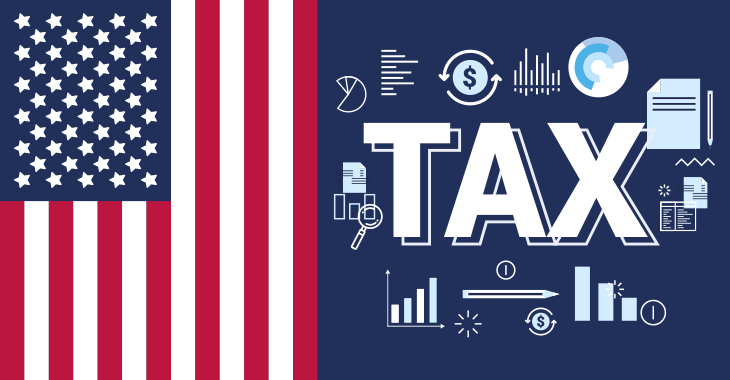
Sales tax on software and SaaS is a tax collected by the seller of the product or service and added to the total cost of that purchase. Sales tax is never supposed to be paid out of your software as a service business’s pocket. You merely play the role of the ‘middle man’ between the customer and the governing body.
In the United States, how you manage sales tax is determined at the state level. Every state has its own set of rules, which makes things rather complicated.
A product may be taxable in one state but not in another. In addition, in some states, items are taxable when written up together on an invoice but not when listed separately.
Online sellers can quickly provide products and services to customers across both state and country borders. As a result, software as a service businesses, which trade online, can find themselves dealing with various sets of laws and rules in different countries or states.
In contrast, you have far fewer tax rules to consider if you have a physical store that only operates in one state, region, or country.
In the United States, you’re responsible for taxes in the following two instances:
➡️ If your business has a sales tax nexus in the same state as your customer.
➡️ If the product or service is taxable in that state through remote sales tax.
We’ll chat a bit more about nexus laws later.
For now, it’s essential to take note that if you’re responsible for sales tax on software and sales tax on SaaS in a particular state, you must charge your customers the correct amount of tax and remit the collected taxes back to the state.
Most physical products are taxable, however, some states have made exceptions for specific products. For example, in some states, digital goods carry a reduced tax rate, while in others, the same items aren’t taxable at all.
It’s imperative that you make it your business to know precisely which sales tax categories your products or services fall into to determine their taxability in the relevant states.
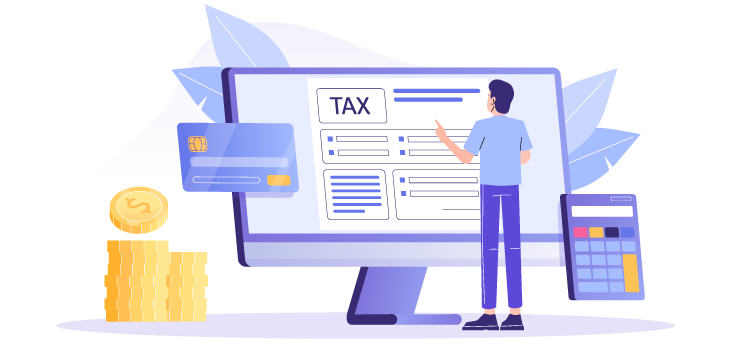
In legal terms, a ‘nexus’ is a connection or link. In most instances, it’s used to establish jurisdiction, prove causation, or solve the conflict of law issues.
In the tax world, nexus laws refer to the connection that a seller must have with a particular area before they’re required to charge and collect sales tax there.
There are two main types of nexus: sales tax nexus and income tax nexus, with the potential for businesses to meet the requirements for one, both, or neither. With a sales tax nexus, a business is liable for collecting and remitting sales tax in that state. With income tax nexus, a business must file income tax returns for that state.
Certain business activities, including having a physical presence or reaching a certain sales threshold, may establish physical nexus within that state. The definition can differ slightly from state to state. However, the general consensus is that if your software as a service business has a brick-and-mortar store or an office in a state, you’re required to collect and submit taxes in that state.
It’s best to check each state’s laws and requirements if you’re not 100% sure whether you have nexus there. The best way to do this is to check with each state’s taxing agency.
Physical nexus is the legal term for a business’s physical presence in a state. In some states, only the slightest presence could translate into a physical nexus.
For example, having an office or warehouse in a state qualifies as a physical nexus. This instance is pretty straightforward, however, in some states having just a single employee working, delivering goods or services there counts as a physical presence.
Be sure to check all the criteria that count as a physical presence. Physical nexus is usually easier to determine than economic nexus.
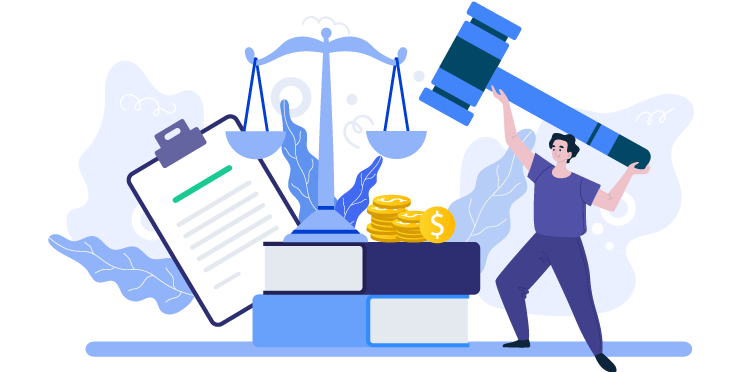
Economic nexus is an economic threshold set out by each U.S. state. When a certain level of sales is achieved, online sellers need to start paying sales tax.
These activities can include sales revenue and/or the number of transactions taking place.
Economic nexus thresholds vary from state to state. If you have an economic nexus in a state that follows economic nexus law, it’s crucial to determine where you meet the relevant thresholds.
Before June 2018, businesses were only required to pay sales taxes where they had a physical presence or nexus. However, in June 2018, a landmark ruling set into motion events that have changed the sales tax landscape. The US Supreme ruled in favor of the state in South Dakota vs. Wayfair, Inc court case. This ruling allowed South Dakota to begin taxing remote sales via economic nexus laws.
Since the ruling, over 40 states have followed suit and created their own economic nexus laws. Unfortunately, this change has made sales tax on software and sales tax on SaaS much more complex for online sellers.
Failing to comply with economic nexus laws can lead to hefty fines or possible jail time in some states. Even if your business isn’t fined, you’ll be required to pay the taxes you haven’t remitted to the relevant state(s).
The nature of economic Nexus laws means this is an incredibly easy and costly mistake to make, especially for a small business selling software as a service.
This act, passed in California on October 1st, 2019, requires that a marketplace facilitator (i.e, Amazon) is responsible for collecting and paying the tax on retail sales made through their marketplace.
Since then, 30 states have implemented a marketplace facilitator ruling. The ruling makes it easier for states to manage sales tax, as they only have to deal with tax from the facilitator rather than multiple sellers.
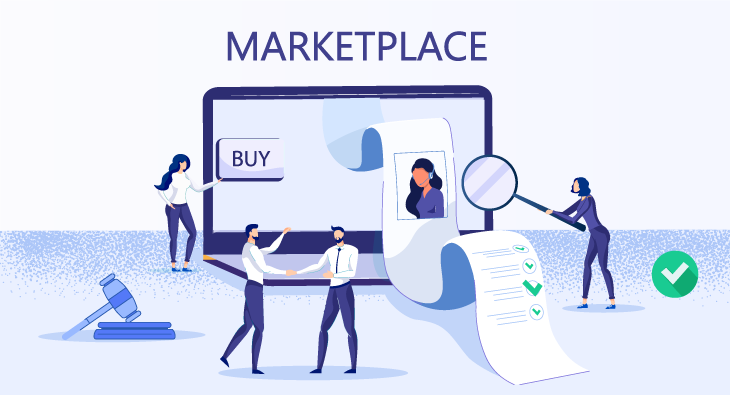
If your business uses a marketplace facilitator such as Amazon, they can collect sales tax on your behalf, taking the responsibility off your hands.
But if you sell across multiple channels, you’re not entirely off the hook. Suppose you use a marketplace facilitator but also sell your product via your company website. In that case, you’re liable for the online sales tax on software and software as a service from your website sales.
There are approximately 14,000 tax jurisdictions in the U.S. This large number may seem difficult to believe as there are only 50 states (and Washington D.C), but taxes are based on the exact address, which takes into consideration if the state is a single rate state or not.
Each state sets a sales tax rate. Then, different jurisdictions within that state can have their own add-ons. For example, a county within a state can add a further percentage to the state rate. Within that county, a district could lay on another additional tax.
Luckily, as an online seller, you’re only required to remit the entire amount to the state — it’s their job to divide it between the various county, city, and district levels.
That said, you still need to make sure you’ve charged the correct tax for each jurisdiction, as well as keep up with any changes that occur in tax rates.
➡️ Sales Thresholds
Once your business reaches a specified dollar amount of sales or a predetermined number of transactions, you have economic nexus in a jurisdiction and are required to pay sales tax.
For example, in the state of Nevada, online sellers must register for sales tax on software and SaaS if they have 200 retail transactions within the state or if they reach over $100,000 of retail sales.
➡️ Evaluation Periods
The evaluation period is the measurement period of the sales thresholds — for example, sales from the current or previous calendar or financial year. It’s essential to check the evaluation periods on a state-by-state basis, as they can differ.
➡️ Timing of Tax Registrations
This refers to the time a business has to register with the state for its sales taxes. This period can be anywhere from the moment the company crosses the economic nexus threshold to up to 90 days after they reach this threshold.

Staying on top of sales tax on software and software as a service can feel like a daunting task with so many tax rules and regulations within different states to consider. Fortunately, some organizations have done the legwork for you and collated the data on sales tax requirements.
Avalara, for example, provides comprehensive information on economic nexus and sales tax laws in each state. This info includes enforcement dates, sales thresholds, evaluation periods, registration requirements, and more.
Read on to learn the common mistakes made by online sellers and the 3 steps to be tax compliant in the U.S. in our all-in-one guide to SaaS online sales tax on PayPro Global’s blog.
COVID-19 showed many of us that job security is a myth. In fact, the pandemic caused one of the worst employment crises since The Great Depression, with the OECD reporting that, in some countries, employees were working only one-tenth of their pre-pandemic hours.
2020 and 2021 saw a rise in entrepreneurship and innovation worldwide, with an increase due in part to the recent economic downturn. From starting software companies as a way of boosting income to feeling that the time was finally right to launch a Software or SaaS product, there is a range of reasons for this recent increase in startups. But whatever the reason, it’s critical to know the risks.
It’s expensive to develop, deploy, and market software, especially at the early stage of a startup, so securing Startup funding can be critical for survival for SaaS companies.
So how can you go about securing SaaS Startup funding? We took a look at the options.

The funding ecosystem is complicated. Knowing who you should get startup SaaS funding from and precisely what funding you need is essential. To make the right choice for your SaaS, you need to do some housekeeping first.
The stage at which SaaS companies are operating helps determine the kind of funding they should chase. We briefly outline the stages below:
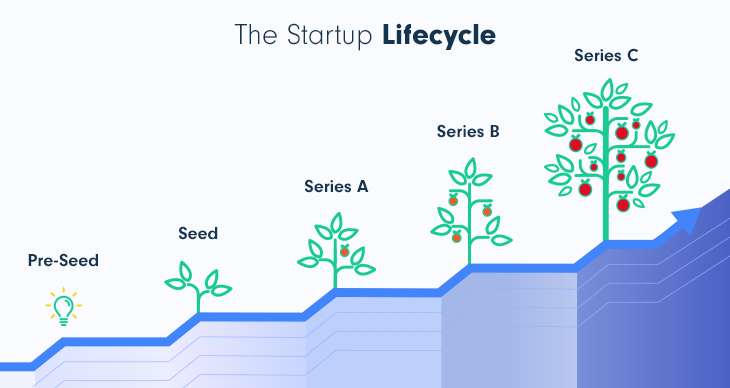
➡️ Pre-Seed Startup Stage
The pre-seed stage is reserved for the smallest SaaS companies. Early-stage startups looking for this type of funding might want help developing a working prototype or getting their product to market.
According to Profitwell, this will require a small capital of around $1 million or less. Getting pre-seed funding is highly competitive. Investors will be looking for well-developed product ideas and solid founding teams to give them the confidence they need to invest in early-stage startups.
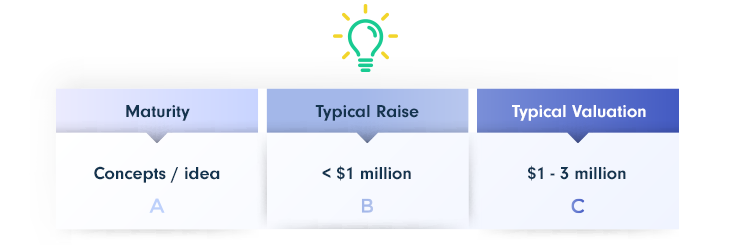
➡️ Seed Startup Stage
The seed stage is commonly seen as the first official equity funding stage, with software and SaaS companies needing to raise between $100,000 and $2 million. You need capital to help meet your product development needs, expand your team, and begin turning a profit at this early stage.
To qualify for funding, your business must have more or less doubled in valuation since the pre-seed round. And, as Investopedia reports, your business should be valued between $3 million and $6 million, though, of course, these are broad guidelines.
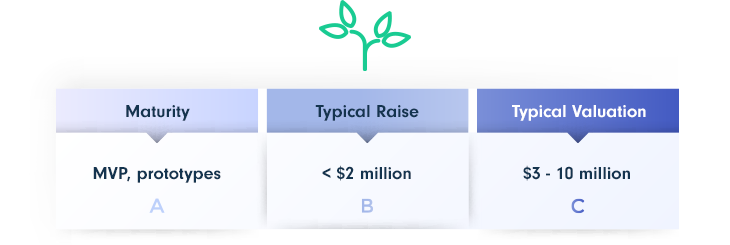
➡️ Series A — Revenue Generation
The Series A funding stage becomes an option when your SaaS or Software business has started generating revenue and you’re looking to expand. At this stage, you need capital to optimize existing business processes.
While the scale of this funding varies, businesses raise around $10 million on average. To attract investors, you’ll need to develop your business model further and show evidence that it can withstand future cash flow fluctuations.
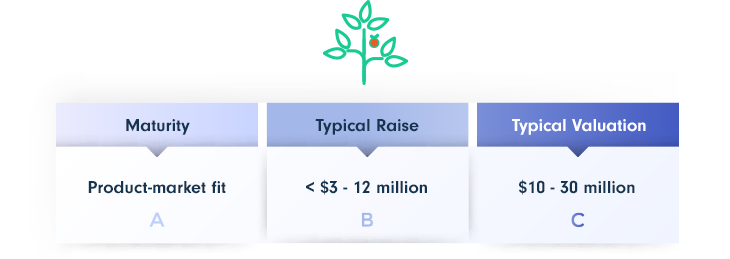
➡️ Series B — Equity-based funding
Series B funding is a form of equity-based funding where you sell shares in your company to investors in return for capital. This capital acts as a cash injection to boost your growth.
The Corporate Finance Institute (CFI) notes that SaaS companies looking for Series B funding need strong valuations of about $10 million. To secure funding, your monetization strategy must have succeeded. In addition, you need to demonstrate that your product is profitable and have metrics in place that prove your business can compete at a certain level.
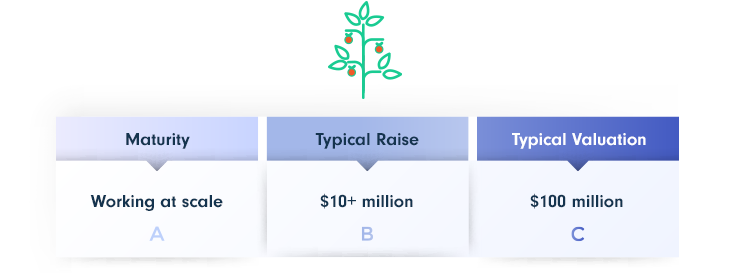
➡️ Series C — Final stage funding
This is the final funding stage. In 2019, Series C Startups raised an average of $103 million, up from $48 million in 2012.
This stage focuses on aggressive expansion. Your SaaS or Software company should be generating sufficient capital for scaling so that investors will get less equity. To qualify for funding, your business must be established enough that the investment risk is low.
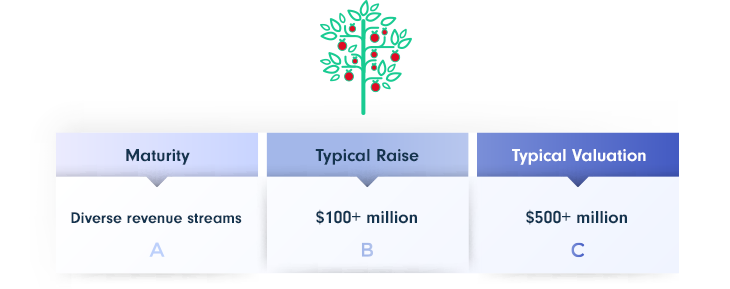
Once you’ve determined the SaaS Startup funding stage you’re in, it’s time to get prepared for your funding journey. Here are a few tips:
➡️ Budget Your Time
Securing Startup funding takes time and consistent effort. You’re likely to go through multiple pitching rounds and re-working sessions, so plan accordingly.
➡️ Prepare Your Documentation
Being organized goes a long way to securing SaaS Startup funding. Prepare your business plan, pitch decks, and financial projections. It’s also helpful to update any legal documentation like your articles of incorporation — the set of documents you must file with a government body to document the establishment of your company.
➡️ Plan Effectively
You’ll need a detailed business plan of exactly how you’ll use your Startup funding to grow your SaaS company.
➡️ Don’t Neglect Your Business
Make sure your business doesn’t suffer while looking for funding, as any decline in growth could deter future investors.
➡️ Grow Your Business
Try to grow your business as much as possible before hunting for Startup funding.
Ready to start looking for SaaS funding? Explore the complete list of the most popular Startup funding options, and learn how to prepare your SaaS funding strategy successfully on PayPro Global’s blog.
Welcome to the Email Marketing Conference
What if you can't watch online?
Here you can learn more, about how to get record of the conference




You have reached the maximum per-minute rate limit.
Try again in one minute.